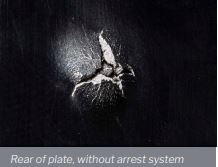26/02/24

Commonly, ballistics shielding applications often take sheets or panels of hardened steel and join
them with welding – a simple yet time consuming process, relying on extensive fabrication. As
such, there may be a trade off between design optimisation and commercial viability of armour
manufacture.
Ultra-hard steel is a reliable and popular choice for armour, providing dense protection from
projectiles, however, with more armour comes more weight, and, until now, there has been
little competition, though there has been much desire for lightweight and commercially viable
alternatives.
Manufacturing titanium with Titomic Kinetic Fusion, also called cold spray, turns metal powder to part in just hours. The process deposits metal powders at supersonic speeds to rapidly build up parts layer by layer, meaning there is no need for casting or forging. This means that Titomic can create custom shapes and monolithic structures at an industryleading rate from high-performance materials, including pure titanium. Because the process creates parts to net-shape, operators can reduce waste often by 90%, as parts don’t have to be machined from a billet.
Finally, Titomic Kinetic Fusion has the capability to fuse dissimilar materials, unlocking new
capability to create composite armour systems, for example, operators can now fuse titanium,
steel, and ceramics, and more, to create new ways of protecting personnel and assets.

Leverage numerous benefits when manufacturing ballistics armour with Titomic Kinetic Fusion.
Titomic Kinetic Fusion has produced and evaluated ballistics armourto NATO STANAG 4569 KE Level 1, 2 and 3 and MIL-DTL-46077G test specifications, and is continuing development for further weight
reduction and performance increases.